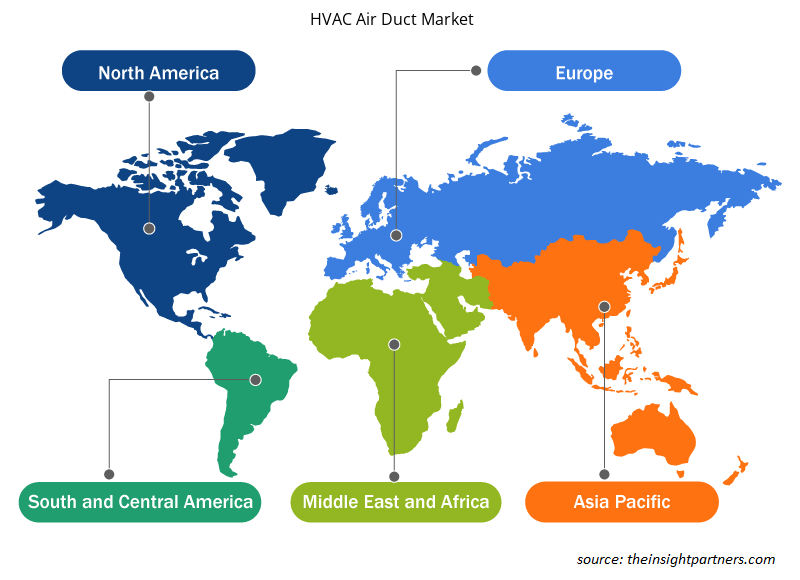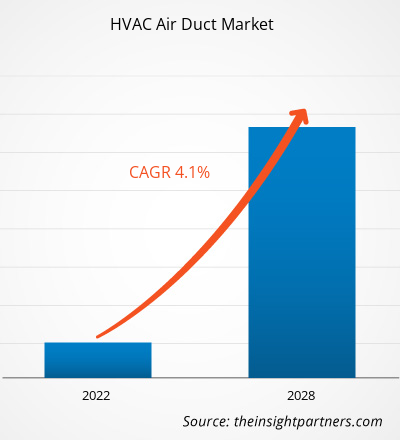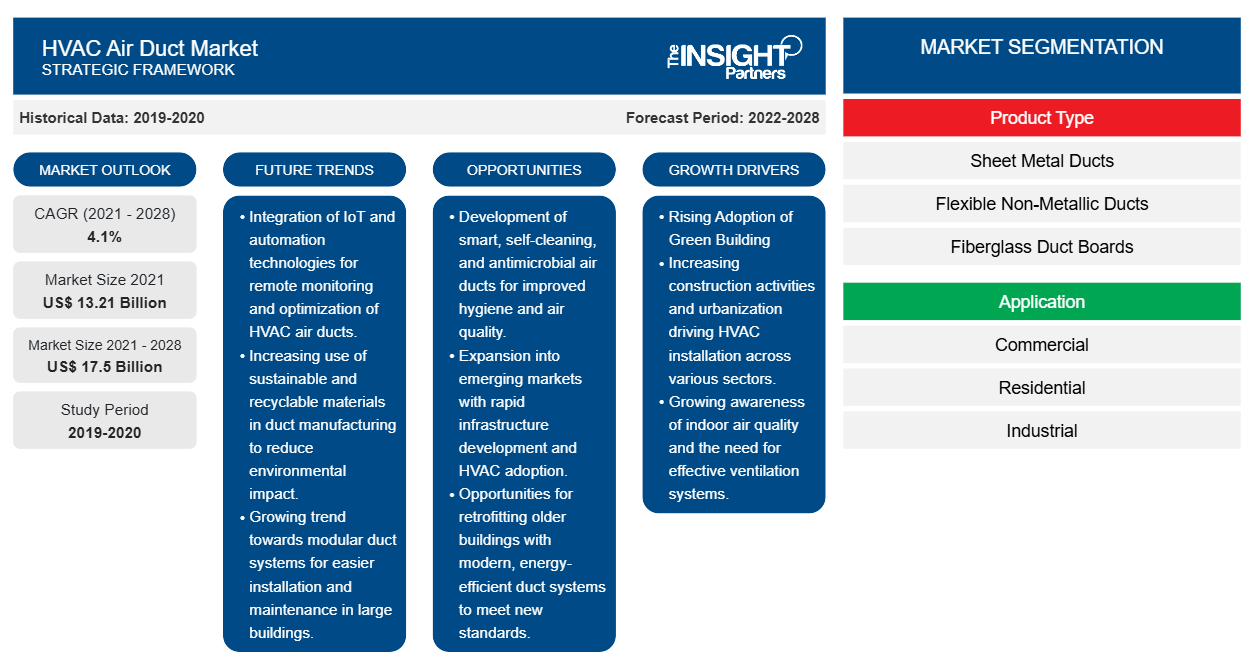Der Markt für HVAC-Luftkanäle wurde im Jahr 2021 auf 13.213,7 Millionen US-Dollar geschätzt und soll bis 2028 17.502,6 Millionen US-Dollar erreichen; von 2021 bis 2028 wird ein durchschnittliches jährliches Wachstum von 4,1 % erwartet.
Die zunehmende Neigung zu umweltfreundlicher Gebäudetechnologie und die steigende Zahl von Rechenzentren treiben das Wachstum des Marktes für HVAC-Luftkanäle voran. Grüne Gebäude bieten viele wirtschaftliche oder finanzielle Vorteile, die für eine Reihe verschiedener Menschen oder Personengruppen relevant sind. Mit der zunehmenden Einführung umweltfreundlicher Gebäude in Ländern wie den USA, Kanada, Deutschland, Großbritannien, China und anderen steigt die Nachfrage nach fortschrittlichen HVAC-Systemen. Viele Architekten und Regierungen im Wohn- und Gewerbesektor implementieren umweltfreundliche Gebäudetechnologie aufgrund ihrer verschiedenen Vorteile, wie z. B. höhere Energieeffizienz, geringerer CO2-Fußabdruck und geringere Auswirkungen auf die Umwelt. Dieser Faktor katalysiert die Nachfrage nach HVAC-Systemen, was wiederum das Wachstum des Marktes für HVAC-Luftkanäle ankurbelt . Darüber hinaus treibt die wachsende Zahl von Rechenzentren auf der ganzen Welt die Nachfrage nach HVAC-Systemen an und treibt somit das Wachstum des Marktes für HVAC-Luftkanäle voran. Darüber hinaus bietet die zunehmende Anwendung von Erdwärmepumpen (GHP) in Wohn- und Gewerbegebäuden lukrative Möglichkeiten für Hersteller von HVAC-Luftkanälen. Die Technologie wird häufig zum Heizen und Kühlen von Gebäuden eingesetzt und ihre breite Akzeptanz dürfte in den kommenden Jahren zu einer steigenden Nachfrage nach HVAC-Luftkanälen führen.
Passen Sie diesen Bericht Ihren Anforderungen an
Sie erhalten kostenlos individuelle Anpassungen an jedem Bericht, einschließlich Teilen dieses Berichts oder einer Analyse auf Länderebene, eines Excel-Datenpakets sowie tolle Angebote und Rabatte für Start-ups und Universitäten.
- Holen Sie sich die wichtigsten Markttrends aus diesem Bericht.Dieses KOSTENLOSE Beispiel umfasst eine Datenanalyse von Markttrends bis hin zu Schätzungen und Prognosen.
Auswirkungen der COVID-19-Pandemie auf den Markt für HLK-Luftkanäle
Die COVID-19-Pandemie hat die meisten Unternehmen weltweit betroffen. Der kontinuierliche Anstieg der Zahl der mit dem Virus infizierten Patienten zwang die Regierungsbehörden verschiedener Länder, die Bewegung von Menschen, Waren und Gütern durch Reisebeschränkungen, Massensperren und Betriebsschließungen einzuschränken. Die Verhängung der Sperren hat zu einer geringeren Produktion von Gütern und Gütern geführt und die Häufigkeit der Dienstleistungsangebote verringert. Die verarbeitende Industrie, die Automobilindustrie, die Halbleiter- und Elektronikindustrie, die Öl- und Gasindustrie, die Luftfahrt, der Bergbau und andere Branchen verzeichneten aufgrund der vorübergehenden Betriebsschließungen einen deutlichen Umsatzrückgang. Im ersten Quartal 2020, nach der Verhängung landesweiter Sperren in den meisten Ländern, kamen viele Industriezweige zum Stillstand. HVAC-Luftkanäle werden in Laboren und in verschiedenen Branchen wie der Pharma-, Lebensmittel-, Elektronik- und Halbleiterindustrie sowie der verarbeitenden Industrie in großem Umfang eingesetzt. Die Nachfrage nach HVAC-Luftkanälen bei verschiedenen kleinen und mittleren Unternehmen war ebenfalls negativ betroffen.Sobald sich die Situation jedoch wieder normalisiert hat, wird erwartet, dass der Markt für HVAC-Luftkanäle im Prognosezeitraum weltweit deutlich wachsen wird.
Markteinblicke – HVAC-Luftkanalmarkt
Steigende Akzeptanz von umweltfreundlichem Bauen
Mit der zunehmenden Einführung von Ökogebäuden in Ländern wie den USA, Kanada, Deutschland, Großbritannien, China und anderen und der Verwendung geothermischer Heiz- und Kühlmethoden aufgrund der steigenden Nachfrage nach HLK-Systemen. Die mit der Technologie für Ökogebäude verbundenen Vorteile wie höhere Energieeffizienz, geringerer CO2-Fußabdruck und geringere Umweltbelastung bewegen viele Architekten und Regierungen im Wohn- und Gewerbesektor, diese Technologie zu implementieren. Dieser Faktor katalysiert die Nachfrage nach HLK-Systemen, was wiederum den Markt für HLK-Luftkanäle ankurbelt. Darüber hinaus suchen gewerbliche Ökogebäude nach einer größeren Menge umweltfreundlicher HLK-Systeme, um ihre Abhängigkeit von Erdölprodukten zu verringern.
Produkttypbasierte Einblicke
Basierend auf dem Produkttyp ist der Markt für HVAC-Luftkanäle in Blechkanäle, flexible nichtmetallische Kanäle, Glasfaserkanalplatten und andere unterteilt. Das Segment der Blechkanäle hatte im Jahr 2021 den größten Marktanteil.
Die Akteure auf dem Markt für HVAC-Luftkanäle konzentrieren sich hauptsächlich auf die Entwicklung fortschrittlicher und effizienter Produkte.
- Im April 2020 produzierte DuctSox, ein renommierter Hersteller von Luftverteilsystemen und Stoffkanälen, Stoffkanalsysteme, die während der COVID-19-Pandemie für medizinische Zelte eingesetzt werden können.
Regionale Einblicke in den HVAC-Luftkanalmarkt
Die regionalen Trends und Faktoren, die den Markt für HVAC-Luftkanäle im Prognosezeitraum beeinflussen, wurden von den Analysten von Insight Partners ausführlich erläutert. In diesem Abschnitt werden auch die Marktsegmente und die Geografie für HVAC-Luftkanäle in Nordamerika, Europa, im asiatisch-pazifischen Raum, im Nahen Osten und Afrika sowie in Süd- und Mittelamerika erörtert.

- Erhalten Sie regionale Daten zum HVAC-Luftkanalmarkt
Umfang des HVAC-Luftkanal-Marktberichts
| Berichtsattribut | Details |
|---|---|
| Marktgröße im Jahr 2021 | 13,21 Milliarden US-Dollar |
| Marktgröße bis 2028 | 17,5 Milliarden US-Dollar |
| Globale CAGR (2021 - 2028) | 4,1 % |
| Historische Daten | 2019-2020 |
| Prognosezeitraum | 2022–2028 |
| Abgedeckte Segmente | Nach Produkttyp
|
| Abgedeckte Regionen und Länder | Nordamerika
|
| Marktführer und wichtige Unternehmensprofile |
|
Dichte der Marktteilnehmer für HVAC-Luftkanäle: Auswirkungen auf die Geschäftsdynamik verstehen
Der Markt für HVAC-Luftkanäle wächst rasant, angetrieben durch die steigende Nachfrage der Endnutzer aufgrund von Faktoren wie sich entwickelnden Verbraucherpräferenzen, technologischen Fortschritten und einem größeren Bewusstsein für die Vorteile des Produkts. Mit steigender Nachfrage erweitern Unternehmen ihr Angebot, entwickeln Innovationen, um die Bedürfnisse der Verbraucher zu erfüllen, und nutzen neue Trends, was das Marktwachstum weiter ankurbelt.
Die Marktteilnehmerdichte bezieht sich auf die Verteilung von Firmen oder Unternehmen, die in einem bestimmten Markt oder einer bestimmten Branche tätig sind. Sie gibt an, wie viele Wettbewerber (Marktteilnehmer) in einem bestimmten Marktraum im Verhältnis zu seiner Größe oder seinem gesamten Marktwert präsent sind.
Die wichtigsten auf dem Markt für HVAC-Luftkanäle tätigen Unternehmen sind:
- Blechbearbeitung von Tin Man, LLC
- Hennemuth Metallbau
- Waves Aircon Pvt. GmbH
- DuctSox
- Lindab
Haftungsausschluss : Die oben aufgeführten Unternehmen sind nicht in einer bestimmten Reihenfolge aufgeführt.

- Überblick über die wichtigsten Akteure auf dem HVAC-Luftkanalmarkt
Der Markt für HVAC-Luftkanäle ist wie folgt segmentiert:
HVAC-Luftkanalmarkt – nach Produkttyp
- Blechkanäle
- Flexible nichtmetallische Kanäle
- Glasfaser-Kanalplatten
- Andere
HVAC-Luftkanalmarkt – nach Anwendung
- Wohnen
- Kommerziell
- Industrie
HVAC-Luftkanalmarkt – nach Geografie
Nordamerika
- UNS
- Kanada
- Mexiko
Europa
- Deutschland
- Frankreich
- Vereinigtes Königreich
- Russland
- Restliches Europa
Asien-Pazifik (APAC)
- China
- Indien
- Japan
- Südkorea
- Restlicher Asien-Pazifik-Raum
Naher Osten und Afrika
- Südafrika
- Südarabien
- Vereinigte Arabische Emirate
- Rest von MEA
Südamerika
- Brasilien
- Argentinien
- Rest von SAM
Markt für HVAC-Luftkanäle – Firmenprofile
- TIN MAN Blechbearbeitung, LLC
- Hennemuth Metallbau
- Waves Aircon Pvt. GmbH
- DuctSox
- Lindab
- Schlüsselfertige Kanalsysteme
- M&M-Herstellung
- Kanalsatz
- US-Kanal
- VK STAHL
- Historische Analyse (2 Jahre), Basisjahr, Prognose (7 Jahre) mit CAGR
- PEST- und SWOT-Analyse
- Marktgröße Wert/Volumen – Global, Regional, Land
- Branchen- und Wettbewerbslandschaft
- Excel-Datensatz
Aktuelle Berichte
Verwandte Berichte
Erfahrungsberichte
Grund zum Kauf
- Fundierte Entscheidungsfindung
- Marktdynamik verstehen
- Wettbewerbsanalyse
- Kundeneinblicke
- Marktprognosen
- Risikominimierung
- Strategische Planung
- Investitionsbegründung
- Identifizierung neuer Märkte
- Verbesserung von Marketingstrategien
- Steigerung der Betriebseffizienz
- Anpassung an regulatorische Trends





















 Kostenlose Probe anfordern für - Markt für HVAC-Luftkanäle
Kostenlose Probe anfordern für - Markt für HVAC-Luftkanäle